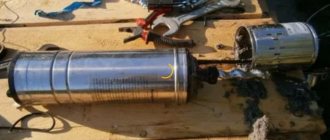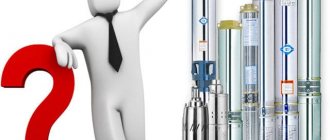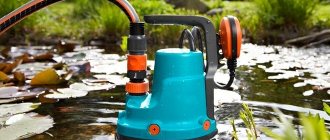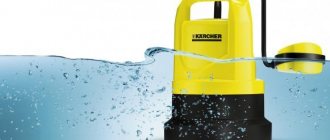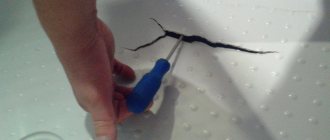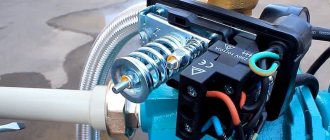Even though centrifugal pumps are reliable devices used for pumping liquids, they may also require repairs. Malfunctions of centrifugal pumps are not always caused by improper operation; this may be due to the quality of the pumped medium, and to a number of other factors. If disturbances occur in the operation of the centrifugal pump, then you must first exclude external causes and only then carry out diagnostics of the equipment itself.
Disassembling the centrifugal pump
Basic malfunctions of submersible pumps
If malfunctions are noticed in the operation of a submersible pump, it does not always need to be removed from the well for inspection. This recommendation only applies to pumping stations that have a pressure switch installed. It is because of this that the device may not turn on, not turn off, or create poor water pressure. Therefore, the functionality of the pressure sensor is first checked, and only after that, if necessary, the pump is removed from the well.
Important! In the case of submersible pumps operating without hydraulic accumulators, they should always be removed from the shaft at the slightest sign of failure.
It will be easier to diagnose water pump malfunctions if you first become familiar with the most common breakdowns of this unit.
Pump doesn't work
The reasons that the pump does not work may be the following.
- Electrical protection has tripped. In this case, you should disconnect the device from the network and turn on the machine again. If it knocks out again, then the problem should not be looked for in the pumping equipment. But when the machine is turned on normally, do not turn on the pump again; you must first find the reason why the protection was triggered.
- Fuses have blown. If after replacement they burn out again, then you need to look for the cause in the power cable of the unit or in the place where it is connected to the electrical network.
- The underwater cable has been damaged. You should remove the device and check the cord.
- The pump's dry start protection has tripped. Before starting the device, make sure that it is immersed in liquid to the required depth.
Also, the reason that the device does not turn on may lie in the incorrect operation of the pressure switch installed in the pumping station. It is necessary to adjust the starting pressure of the pump motor.
The pump works, but does not pump
There may also be several reasons why the device does not pump water.
- The shut-off valve is closed. You should turn off the device and slowly open the tap. In the future, you should not start the pumping equipment with the valve closed, otherwise it will fail.
- The water level in the well has dropped below the pump. It is necessary to calculate the dynamic water level and immerse the device to the required depth.
- Check valve stuck. In this case, it is necessary to disassemble the valve and clean it, if necessary, replace it with a new one.
- The inlet filter is clogged. To clean the filter, the hydraulic machine is removed and the filter mesh is cleaned and washed.
Low device performance
Advice! If the performance of pumping equipment drops, you should first check the voltage in the network. It is precisely because of its reduced value that the engine of the unit cannot gain the necessary power.
Reduced performance also causes:
- partial clogging of valves and faucets installed in the water supply system;
- partially clogged lift pipe of the device;
- pipeline depressurization;
- incorrect adjustment of the pressure switch (applies to pumping stations).
Frequently turning on and off the device
This problem occurs if a submersible pump is paired with a hydraulic accumulator. In this case, frequent starts and stops of the unit may be caused by the following factors:
- the pressure in the hydraulic tank has dropped below the minimum (by default it should be 1.5 bar);
- the rubber bulb or diaphragm in the tank has ruptured;
- The pressure switch is not working correctly.
Water is supplied with pulsation
If you notice that water from the tap does not flow in a constant stream, then this is a sign that the water level in the well has decreased below the dynamic level . It is necessary to lower the pump deeper if the distance to the bottom of the shaft allows this.
You can hear the hum of the machine, but the water does not pump
If the pump hums and water is not pumped out of the well, there may be several reasons:
- “gluing” of the device’s impeller with its body occurred due to long-term storage of the device without water;
- the engine start capacitor is faulty;
- the voltage in the network dropped;
- The pump impeller is jammed due to dirt accumulated in the device body.
The unit does not turn off
If the automation does not work, the pump will work without stopping, even if excessive pressure is created in the hydraulic tank (as can be seen from the pressure gauge readings). The culprit is a pressure switch that has failed or is incorrectly adjusted.
How deep water pumps work
To use reserves from underground sources, wells or boreholes, it is best to use deep-well pumps. Their operating principle is as follows:
- The unit is lowered into the liquid to a level below the surface level.
- The pressure created in the device forces water to be pushed upward, for which a hose or pipe for a deep-well pump is installed.
- Simple devices of this type can get water from a depth of up to 40 meters, more technologically advanced and expensive ones - up to 80 meters.
- There are two main categories of pumps:
- for pure water, used to obtain liquid purified from impurities. Most often they are made multi-stage.
- dirty.
Nuances of breakdowns depending on the brand of pump
When operating pumps from different manufacturers, it was noticed that some brands of devices often suffer from the same breakdowns. It follows from this that these models of units have their own distinctive features in terms of the occurrence of malfunctions.
Aquarius
Aquarius pumps are prone to overheating, especially if they operate in shallow wells. If a cheap model breaks down, repairing it costs approximately 50% of the cost of a new device. If the device fails, it is easier to throw it away than to repair it.
Grundfos
Most models from this manufacturer have a valve system. There is also special thermal insulation around the engine. Sometimes pump malfunctions occur due to failure of the listed parts. Since the thermal insulation gasket is located around the motor, it will need to be removed from the housing for repairs.
Baby
“Malysh” devices are products of domestic manufacturers. The cost of repairing units of this brand is not high, and most of the breakdowns are fixed by the owners of the devices themselves. The main failure that often occurs in this pump is the occurrence of strong noise when the hydraulic machine operates without pumping out liquid. This behavior of the apparatus means that a rupture has occurred in the central axis holding the anchor and the membrane.
Gilex
The engine in vortex and rotary type pumps “Dzhileks” is oil-filled. Therefore, a frequent breakdown of these units is oil leakage from the engine. It can only be topped up at a service center.
Important! Many on the Internet advise using transformer oil or regular glycerin instead of the original oil filler. Doing this is highly discouraged, of course, unless you have set yourself the goal of ruining your equipment in an unusual way.
Brook
There is an opinion that the operation of the “Rucheek” drainage pumps can continue without stopping for 7 hours or more. This is explained by the peculiarity of their design, which meets all European standards. But despite this, the device is subject to overheating in the same way as pumps from other manufacturers. Therefore, it is recommended to give it time to “rest” after every 2-3 hours of operation of the device.
Marquis (Marcus)
Owners of the Marcus well pump sometimes notice that the device turns on only after a slight blow either to the pipe going to it, or after a blow to the hydraulic machine itself. This malfunction is explained by the “souring” of the impeller, which will have to be cleaned by disassembling the unit.
Correct operation and maintenance
There are no hydraulic systems with identical performance characteristics. It is impossible to develop universal regulations defining the frequency of inspections. There are standards recommended by manufacturers. Regular maintenance of a centrifugal pump is the key to trouble-free operation of the system.
Basic information about the device is indicated in the passport and manual. The documents list the requirements for acceptance, maintenance, repair and storage of equipment. There is a section with a list of reasons leading to unit failure. The main and auxiliary characteristics (pressure, flow) are indicated. Attached are drawings of the mechanism: a view in three projections.
How to disassemble a unit to diagnose a breakdown
If the pump breaks down and requires replacement of parts located inside its housing, the unit will need to be disassembled. A submersible pump consists of a motor compartment and a compartment with one or more impellers, the purpose of which is to capture water . Below is a diagram of the structure of that part of the centrifugal pump where the impellers are installed.
As can be seen from the figure, the impellers are installed on the shaft of the unit. The more there are, the higher the pressure created by the pump. A rotary engine is located in the second compartment of the hydraulic machine. It is in a sealed case, and to open it, you need to know some nuances.
So, to move from theory to practice and disassemble the pump, follow these steps (depending on the manufacturer, the design of the unit may differ).
- Unscrew the 2 screws holding the device grid.
- Remove the screen and rotate the motor shaft by hand. If it does not spin, then the problem may be either in the engine compartment or in the pumping part of the device.
- First you need to disassemble the pumping part of the device. Unscrew the 4 screws holding the power cable channel and disconnect it from the device body.
- Next, you should unscrew the 4 nuts holding the pump flange.
- After unscrewing the fasteners, separate the pumping part of the device from the engine. At this stage, it is possible to determine in which section the jamming occurred. If the pump compartment shaft does not rotate, then it is necessary to disassemble this unit.
- Unscrew all the fasteners holding the lower flange of the pump part of the unit.
- An adapter must be screwed into the fitting located at the top of the block, which will help protect the thread from damage.
- Secure the pump in a vice.
- Having selected a suitable tool, unscrew the lower flange.
- Now you can pull out the impeller assembly and inspect it to identify any problems.
- Next, you should check the support shaft for wear or play.
- To replace (if necessary) the impellers, you need to fix the shaft in a vice and unscrew the top nut.
- At the next stage, the blocks are removed, washed and, if necessary, replaced with new ones.
- Reassembling the pump part of the device is carried out in the reverse order.
- To disassemble the electric motor, it also needs to be secured in a vice.
- Next, you should remove the plastic flange protection by unscrewing the fasteners.
- Remove the retaining ring holding the cover in place using pliers.
- Remove the cover using a flat-blade screwdriver.
- Remove the rubber membrane from the housing.
- Remove the capacitor.
- At this stage, you can check the oil level, its quality, identify the cause of jamming, etc. The engine block is assembled in the reverse order.
Trouble-shooting
To restore the functionality of the equipment, the unit is first dismantled, and after repair it is reassembled. The greatest difficulties are caused by operations: disassembling bearing units, liners, hydraulic bearings, pressure flange, coupling half.
Removing the impeller from the shaft requires maximum care. To prevent seizing, it is important to carefully remove the impeller. The process is performed alternately with each section. If the impeller is jammed (or the element is difficult to remove), the assembly is slightly heated.
Sometimes inexperienced users cannot assemble the structure. To prevent mistakes, it is recommended to take photographs of sections and individual parts after dismantling.
The assembly plan includes operations:
- reconciliation with the drawing to determine how well the new element complies with the regulatory documentation (drawing);
- monitoring the compatibility of components: recently purchased and previously installed;
- grinding and lapping of mating surfaces;
- uniform tightening of fasteners using a torque wrench (the purpose of the tool is to control the force);
- checking the accuracy of installation of the impeller on the shaft: the axial clearance in all directions must be the same;
- error control of the end side of the hydraulic foot: permissible deviation from the perpendicular axis - no more than 0.02 mm.
Experts warn: welding should not be used to restore the integrity of the housing or impeller. Statistics show the fragility of repaired parts.
Replacement and repair of faulty parts
Now that you know how to disassemble a hydraulic machine, you can try to repair a submersible pump yourself.
Impeller
Basically, blocking of the impellers occurs due to their clogging with sand or due to the formation of a coating of dirt on them. In addition, the impellers can be soldered together when a high temperature occurs in the block when the pump is idling (dry running). To repair this section of the unit, it is necessary to remove the impeller(s) and remove accumulated dirt. If the impellers are damaged, they will need to be replaced with new ones.
Engine
It is not recommended to independently repair the pump motor, since diagnosing this unit and subsequent repairs requires special knowledge and the necessary equipment.
In some pump models, removing the motor will require pressing it out using special equipment. Replacement of the oil seal and bearing is also carried out at the service center.
Capacitor
If the engine hums and does not start, you should check the capacitor. It is located in the pump block in which the motor is installed.
Advice! Before disassembling the engine block, try turning the engine shaft with the pump block disconnected. If the shaft rotates, then the reason may be that the impellers are jammed.
But when the shaft with impellers rotates without problems, then in order to eliminate the hum in the water pump, you should disconnect the capacitor and replace it with a new one. Of course, it is better to check this part with a multimeter, since similar symptoms can be caused by a short circuit in the motor windings.
Oil
The water pump motor is located in a special glass filled with oil, and by its condition it is possible to determine some breakdowns in the electric motor block.
- The oil has a characteristic, unpleasant odor. This means that the engine is still in working condition, but was working under heavy overloads.
- Cloudy oil - water has entered the engine housing due to a crack in the housing or failure of the oil seal (cuff).
- Black oil with an unpleasant odor. In this case, we can say with great confidence that the varnish was burning on the engine coils.
Important! Normally, the oil should be transparent. Its quantity is determined by the model of the unit. On average, the volume of oil poured into the chamber is 0.5 liters.
If, when opening the engine, the above changes in the quality of the oil were noticed, then you first need to repair this unit, and only then fill in new lubricant.
Content
- Correct operation and maintenance
- Equipment operating rules
- Maintenance Regularity
- Centrifugal pump repair
- Troubleshooting
- Trouble-shooting
- How to apply for spare parts
The principle of operation of the device is based on the conversion of the rotational force of the mechanism into fluid energy. The main structural elements are the impeller (impeller), central shaft, inlet and outlet openings, and electric motor.
The units work with different fluids: inert and chemically active, hot and cold, contaminated and purified.
When the electric motor is turned on, the impeller begins to rotate: due to traction, a pressure difference (vacuum) occurs. Under the influence of centrifugal force, the liquid flow is directed into the suction pipe. The water is released through the pressure hole.
What is the phenomenon of cavitation
Everyone knows that a certain amount of gases is dissolved in water. When a liquid moves at a certain speed, rarefaction zones sometimes form in it. In these areas of low pressure, gas bubbles begin to emerge from the water. Once the bubbles enter the high-pressure zone, they collapse. This process occurs with the release of a large amount of energy, which destroys the impellers and volute of the pump. The following photo shows a unit impeller destroyed by cavitation.
The energy from the collapsing bubbles can create shock waves that cause vibration. It spreads throughout the entire unit and affects not only the impeller, but also the bearings, shaft and seals, causing these parts to quickly become unusable.
The cavitation effect can most often be observed in pumping stations that operate on suction . In such systems, the impeller creates a vacuum, due to which water rises through the hose from the well. But if there is a lack of liquid at the pump inlet, then excessive vacuum occurs in the impeller area, causing cavitation.
Important! The most obvious signs of cavitation are vibration of the pipes and the pump itself, as well as increased noise during its operation. If no measures are taken to eliminate this process, it can completely destroy the station.
To prevent cavitation from occurring in pumps, you should adhere to the following rule: there must be more water at the inlet than at the outlet. This can be achieved in several ways:
- you should move the device a little closer to the source;
- you can increase the diameter of the suction pipe (hose);
- to reduce resistance in the suction section, the suction pipe can be replaced with a pipe made of a smoother material;
- if there are many turns in the suction pipe, then, if possible, their number should be reduced;
- It is desirable that all bends have large turning radii.
Advice! The suction hose of the station should not be lowered into the well to a depth of more than 8 meters. Typically, the maximum immersion depth of the hose (pipe) is indicated in the equipment manual.
Criteria for choosing a drainage pump
Let's summarize how to choose a drainage pump. When purchasing the necessary unit, focus on the following points:
- Equipment operating conditions. Although drainage pumps can easily handle pumping wastewater, technical characteristics are limited by the degree of contamination (it should not exceed permissible parameters). In other words, large stones, a high percentage of sand in the liquid, silt and dirt can negatively affect the operation of the unit. That is, to eliminate flooding in basements, you can use a conventional drainage pump. But if you need to drain a reservoir, a solid platform with a flat surface is placed under the bottom of the pump. And if the work area is a construction site, then it is optimal to resort to the help of a powerful fecal pump with a grinder.
A drainage pump can drain even a pond
- Arithmetic calculations. When calculating the required power of the equipment, keep in mind that 1 meter of vertical length is equal to 10 horizontal meters. This means that if your sewer pit is 5 m deep, then the length of the hose should not be more than 50 m. In this case, the drainage speed will be low, although drainage pumps operate in conditions of constantly rising water. In order for the pump to cope with its task flawlessly, add to the height of the rise of the drains the length by which the outlet pipe will be laid horizontally along the surface of the earth. If even then the pressure is not optimal, an “allowance” of length should be added - approximately 3 m.
The lower the lifting height of the wastewater, the more efficient the pump is.
Pro tip:
When choosing a drainage pump, mainly pay attention to its power. Only this parameter determines the optimal use of this or that equipment
- Selection of the drainage pump model is made depending on the condition of the surface where the drainage pump will be installed. It is best to install the drainage pump in a pit, the depth of which is from 40 to 60 cm. This will protect against water getting onto the basement floor. The pump can then be equipped with a vertical float mechanism, which will turn on the equipment as the recess is filled, leaving the floor dry. If it is possible to organize a pit with a width and length of 50 cm or more, any type of float will do.
A pump with a float will not allow maximum drainage
When it is necessary to drain the tank as much as possible, a special drainage pump is needed, which is mounted on a hard surface. In this case, a float is not needed, since it will start working only when the wastewater level is at least a few cm. In all other cases, conventional models will cope with the task.
Types of drainage pumps
Such units for pumping out dirty water and wastewater can be surface or submersible according to their purpose (read: “Drainage pump for dirty water - which is better, surface or submersible”).
The drainage pump has two pipes:
- inlet - for collecting dirty water from the waste tank;
- output - necessary to drain the liquid outside the container.
During operation of the device, it is necessary to ensure that no water gets into it (read: “How the drainage pump works, what is the purpose of the drainage pump and the principle of its operation”). Otherwise, the unit may fail and then you will need to repair the drainage pump yourself or with the help of a specialist. Pumping out wastewater should be done faster than the level in the well rises. The pumps are connected to the sewer system via pipes. To do this, measure the diameter of the sewer pipe with an accuracy of one millimeter.
The advantage of surface pumps is their mobility - they can be easily and quickly moved to another location.
Submersible drainage pumps
. This type of device is used when it is necessary to clean deep tanks and in case of large-scale flooding to pump out excess water. The unit is lowered into a well or container, from where the liquid needs to be pumped out (for more details: “Drainage pump for a well: how to choose”). Suction is produced through holes in the bottom of the device, and not through inlet hoses. To prevent large impurities from entering the impeller of the device, the pump has strainers.
The use of float switches allows you to automatically turn on the device when there is a large number of drains. The possibility of a short circuit when the device is immersed in liquid can be avoided due to the presence of high-quality electrical insulation. If it is necessary to pump out or pump liquid with large fractions, experts recommend using fecal (sewage) pumps that have special cutting and chopping elements. They are capable of pumping and processing wastewater containing large-sized waste. The most optimal solution would be to purchase an automatic sewerage station, which will allow the operation of bathrooms that do not have a connection to centralized wastewater systems.
Criteria for selecting drainage pumps
There are several rules that should be followed when choosing a device: It is necessary to take into account the type of liquid being pumped - here they pay attention to the size of the fractions in dirty water. You need to carefully familiarize yourself with the main parameters of the drainage unit in order to choose a specific model.
- pressure – this value for equipment of average productivity is 7-10 meters. In some models it reaches more than 30 meters. Data regarding pump pressure depend on the distance over which the liquid is planned to be supplied;
- productivity - the choice depends on the volume of the tank. For example, for a capacity of 40 “cubes”, a device with 10 cubic meters of productivity per hour is sufficient. For industrial purposes, more efficient pumps are needed - about 100 m³ / hour or more;
- immersion depth of the device - the maximum value reaches 5 -15 meters, and the minimum - 0.3 - 0.9 meters.
It should be remembered: when the unit is operating, its pumping part must be under water.
In addition, you need to know what factors determine the lifespan of the pump:
- the quality of the materials from which the equipment elements are made;
- the temperature of the pumped dirty water should not be more than +50°C;
- drain passage diameter;
- presence of protection against possible overheating. Typically, a thermal relay is built into the pump (it will turn off the power if the liquid temperature becomes critical) and a float switch.
What distinguishes a drainage pump from a fecal pump?
The drainage pump is capable of operating in environments with solid particles
The purpose of drainage pumps is to pump out and remove water and wastewater with foreign impurities from various reservoirs: pits, mines, drainage pits, domestic sewer pipelines, industrial systems and other treatment plants. With their help, you can pump out and drain fecal wastewater, servicing multi-story buildings, and also use the equipment in case of flooding of basements.
Although both drainage and fecal pumps operate in similar environments, there is a fundamental difference between them - for each type, the permissible size of solid impurities in wastewater is determined. For drainage pumps, these are particles with a diameter of 3 ÷ 12 mm (depending on the model of the unit) and up to 120 mm (these pumps are capable of pumping out large volumes of sewage).
Fecal pumps operate in liquids where solid inclusions are either completely absent or their size is small. Due to this feature, the equipment is equipped with knives and other cutting mechanisms that play the role of a suspension grinder. The pump impeller can be semi-open, single-channel or vortex.
Repair of drainage pumps
The faults listed above for the drainage pump cannot always be corrected on your own. You can independently fix a weakened shock absorber, release or replace the float, eliminate mechanical damage that resulted in jamming of the impeller, and replace the power cable.
The simplest of all this will be securing the shock absorber. To do this, you will need to disassemble the device body and tighten the loose nuts on the mounting bolts. It is imperative to lock the top nut to prevent further loosening. It will take some time to replace the power cable. Replacing the condenser is possible in some drainage models.
Other faults are practically impossible to eliminate without the involvement of service workshops. For example, if a rod is broken, it is easier and sometimes cheaper to purchase new equipment than to disassemble it and try to repair it. Replacing a valve is a difficult and unprofitable undertaking to solve the problem on your own. Replacement of a burnt winding should be carried out in specialized workshops.
Disassembling the Belamos DWP CS drainage pump
The most common causes of breakdowns
If there is a need to repair pumping equipment, it is necessary to find out the probable cause of its failure, which are often:
- Failure to comply with the terms of periodic inspection and repair of equipment.
- The equipment was not operated correctly. During operation of the device, its operating parameters were exceeded.
- The pumped liquid contains solid impurities larger than required.
- Long-term use of the pump in dry mode.
- The equipment was installed incorrectly or poorly.
- The hydraulic accumulator and relay are out of order, and there is no filter.
When the first hint of a breakdown appears, you should immediately check the following components of the device: The ideal distance between the electromagnetic coils and the piston should be set from 0.4 to 0.5 cm. If these distances are not observed, the coils will beat if the gap is too large and the motor will overheat if the gap is too small.
Draining a reservoir with a drainage pump
The piston must not have mechanical damage or defects, its condition must be elastic. The valve covering the inlet holes must have a gap between the body of 0.7 to 0.8 mm. Air should flow freely when blowing on the intake side. It often happens that poor pump performance is not due to its breakdown. There may be power outages in the network.
Therefore, before you begin disassembling the device, make sure that the mains voltage matches, which should be 220-240 V. It should be noted that for long-term and reliable operation of the pumping equipment, it is necessary to carry out timely technical inspection and maintenance of the device and follow the rules of technical operation.
Disassembling the “Baby” pump
Before repairing the Malysh pump, it must be properly disassembled. The main thing in this matter is not to damage entire parts, and remember the procedure in order to correctly assemble the mechanism after repair. Before disassembling, drain the water from the pump and turn off the power. Next, you need to use a sharp object or marker to apply marks on the two halves of the body in order to align them correctly during assembly.
Then the body of the “Baby” is clamped in a vice in a vertical position, just below the joining seam of the upper and lower parts. All fastening bolts are unscrewed, and the upper part of the mechanism body is removed. Next, unscrew and remove the fixing nut from the vibrator bushing, and remove all the parts put on the rod. Main components of the vibration pump:
- Piston.
- Diaphragm with stop.
- Electric coupling.
- Shock absorber.
- Anchor.
All of the above spare parts are strung on the central rod, and washers and locknuts are installed between them.
